
Back George Yonge Afrikaans George Yonge Danish George Yonge Spanish جرج یانگ Persian George Yonge French ג'ורג' יאנג HE George Yonge, V baronetto Italian George Yonge NB
Sir George Yonge | |
|---|---|
 Portrait by Edmund Scott, 1790. | |
| Secretary at War | |
| In office 1783–1794 | |
| Monarch | George III |
| Preceded by | Richard FitzPatrick |
| Succeeded by | William Windham |
| In office 1782–1783 | |
| Monarch | George III |
| Preceded by | The Viscount Sydney |
| Succeeded by | Richard FitzPatrick |
| Governor of the Cape Colony | |
| In office 10 December 1799 – 20 April 1801 | |
| Monarch | George III |
| Preceded by | Francis Dundas |
| Succeeded by | Francis Dundas |
| Member of Parliament for Honiton | |
| In office 1763–1796 | |
| Preceded by | Henry Reginald Courtenay |
| Succeeded by | George Chambers |
| In office 1754–1761 | |
| Preceded by | Sir William Yonge |
| Succeeded by | John Duke |
| Personal details | |
| Born | 17 July 1731 Great House, Colyton, Devon, England |
| Died | 25 September 1812 (aged 81) Hampton Court Palace, Surrey, England |
| Resting place | Colyton, Devon, England |
| Spouse |
Ann Cleeve (m. 1765) |
| Parent |
|
| Education | Eton College |
| Alma mater | University of Leipzig |
Sir George Yonge, 5th Baronet, KCB, PC, FRS (/jʌŋ/; 17 July 1731 – 25 September 1812), of Escot House in the parish of Talaton in Devon, England, was a British Secretary at War (1782–1783 and 1783–1794). He succeeded to his father's baronetcy in 1755, which became extinct when he died without children. He is remembered by, among other things, the name of Yonge Street, a principal road in what is now Toronto, Canada, so named in 1793 by the Lieutenant-Governor of Upper Canada, John Graves Simcoe.
© MMXXIII Rich X Search. We shall prevail. All rights reserved. Rich X Search